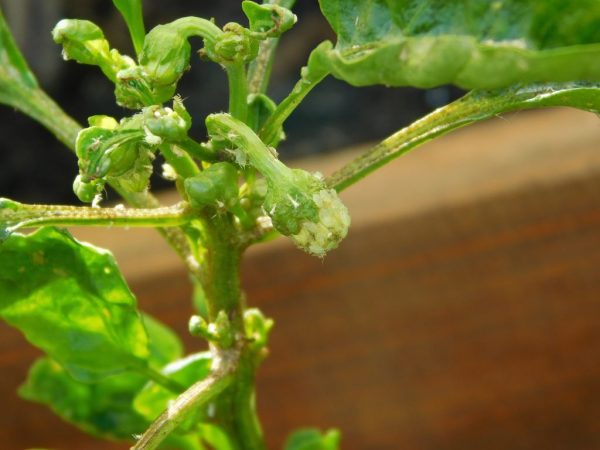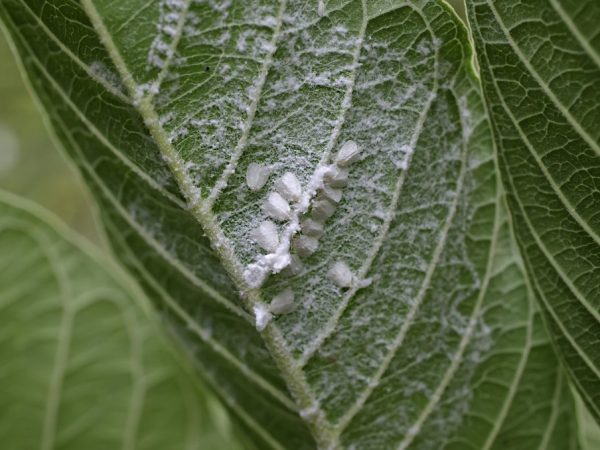Sweet pepper pest control methods
The main pests of sweet peppers are aphids, spider mites, naked slugs, whiteflies, and bears. The fight against them is carried out by folk methods or chemicals.

Sweet pepper pest control methods
Aphid
Aphids are the most dangerous pest of bell peppers. These are black or white bugs.
Features of the pest:
- feeds on plant sap;
- located on the underside of the sheet;
- appears on leaves, stems, fruits in whole colonies;
- multiplies very quickly.
Under the influence of aphids, the leaves gradually turn yellow. After 2-3 days, curl up and then dry out.
Control methods
The fight against this pest on sweet pepper is carried out in 3 ways.
| № | Method name | Description |
| 1 | Use of fungicides (chemical method) | Usually, when fighting aphids, 2 drugs are used: Keltan and Karbofos. Take 1 tsp. each product and diluted in 10 liters of warm water. The infusion time is 2-3 hours. They can only be used before or after flowering. At other times, they harm the fruit, make them bitter and tasteless. |
| 2 | Tobacco dust solution (folk method) | Take 1 tbsp. (200-250 ml) tobacco dust. It can also be replaced with wood ash and used in the same proportions. This amount is poured into 10 liters of water, let it brew for 15-20 hours. The solution is thoroughly mixed. Add 2 tablespoons to it. liquid soap. The tobacco dust solution is introduced early in the morning or late in the evening. Can be poured at the root or irrigated throughout the plant. |
| 3 | Millennial infusion (folk method) | Requires 1 tbsp. l. crushed flowers. They are mixed with 400 ml of water. The mixture is boiled for half an hour, after which it is allowed to brew for another 2 hours. Strain before use. |
Spider mite
This pest of sweet bell pepper often lives on the back of the leaves, forming a cobweb.
Spider mites only appear during dry periods or hot weather.
If the pest is not noticed and removed in time, small marble dots will soon appear on the plant. These are the larvae of spider mites that eat bell pepper leaves.
Subsequently, the leaves change color, wither, curl and fall off. The fruit is damaged, due to which the plant dies.
Control methods

A tick can kill a plant
In the fight against mites, the top layer of the soil is treated with a solution of bleach. To prepare a 10% mixture, you need 1 kg of dry preparation. The component is gradually mixed with water and mixed until a thick slurry is formed. After that, the mixture is poured into 10 liters of water. The solution can be used immediately after preparation and only the affected areas of the sweet vegetable can be treated with it.
If a vegetable crop is grown in a greenhouse, phytoseil beetles are launched inside the room. They feed on spider mites. After a week, there will be no traces of the pest.
The chemicals also help fight spider mites. The most popular among them:
- Akarin;
- Apollo;
- Actellik;
- Dicofol 20%;
- Kleschevite.
They kill spider mites in just 2-5 days.
Naked slugs
Slugs live on the leaves of vegetable crops.These pests of bell pepper make holes in the leaf plates and suck out the juice, after which they eat the fruits, leaving traces in the form of white mucus. The bush eventually rots.
Naked slugs actively move throughout the vegetable during the rainy season or after abundant watering. During the day they often hide in dark places in the ground.
Control methods
To fight slugs, the soil is irrigated with quicklime. They bring it in carefully so that it does not fall on healthy bushes. The number of sprinkles per day is 3-4, depending on the stage of the lesion.
If this does not help to deal with them, chemicals are used. The most effective is a granular preparation of metaldehyde. The granules are placed where the traces of slugs have appeared. It is enough to dilute 5 g of metalgide in 10 liters of water and treat the infected bushes using drip irrigation. This is enough for spraying 1 sq. m of beds.
The main preventive measure is the timely harvesting of weeds, because they are ideal breeding grounds for naked slugs.
Whitefly

Insects feed on plant sap
It is a small white insect that resembles a moth. It multiplies under high temperature conditions. She not only in itself is harmful, but also provokes the development of fungal diseases.
Like other pests, it feeds on vegetable juice. The first sign is the appearance on the leaves of a white and shiny bloom. Under the influence of the whitefly, the plant stops growing. The leaves turn yellow, curl. As a result of inaction, the plant dies.
Control methods
The easiest way to combat this sweet pepper pest is with a soapy solution. 200 ml of liquid soap is diluted in 10 liters of water. All leaves where the whitefly was found are washed with the solution.
After that, the soil around the vegetable crop is loosened and peat bedding is added. The layer cannot be less than 2-5 cm in height.
Other methods of dealing with whitefly:
| № | Method name | Description |
| 1 | Spraying with chemical solution | Fungicide "Commander" is suitable for these purposes. Take 1 g of the solution, which is diluted in 1 bucket of water. It is watered with about 8-10 bushes of vegetable crops. This allows you to keep the sweet taste of the peppercorns and does not harm the plant. |
| 2 | Planting tobacco | Whitefly loves this plant very much. If you plant it next to the pepper, after 2-3 days there will be no insects, because they will switch to tobacco. |
| 3 | Chemical treatment | Intavir is an effective remedy for a large number of whiteflies. You just need to dissolve 1 tablet in a bucket of warm, settled water. Another quality drug is Verticillin. Take 100 g of the product, dilute in 10 liters of water. Sprayed for 10 days three times a day. Iskar-M will hatch whiteflies in a week. For 1 bucket of water, you will need 2 ampoules. |
Medvedki
Bell peppers also affect the bears. These are beetle insects up to 5 cm long. Their distinctive feature is their brown color. Unlike other insects, bears feed on vegetable roots. As a result, the plant stops growing, withers and dies.
Control methods
The nests where the bears live are poured with kerosene or boiling water in large quantities.
Medvedka does not tolerate the smell of marigolds, so this particular plant is planted next to the pepper. Insects either die or move to other vegetable crops.
Another solution to the problem is to create traps. At 10 days of May, manure is laid out on the site (2 heaps per hundred square meters). After 20 days, the manure is examined for the presence of bears. They are removed along with the fertilizer.
Conclusion
Sweet bell peppers are affected by various pests: bears, aphids, spider mites, whiteflies, naked slugs. In the fight against them, folk remedies or chemicals help. Timely detection of the pest and immediate control of it helps to preserve the harvest.


